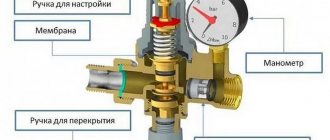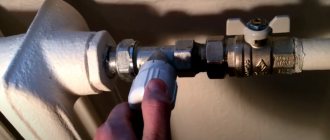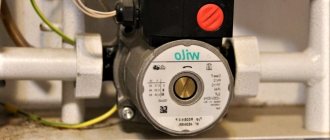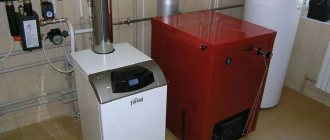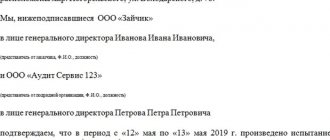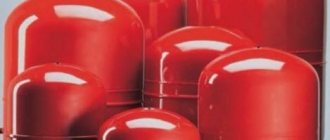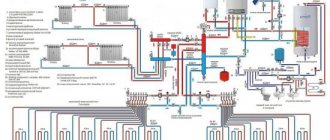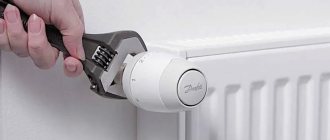Automation services for central heating and heat supply systems in order to save heat in Moscow. Automatic central heating and heat supply systems are installed in apartment and multi-storey buildings, residential buildings, factories, kindergartens, schools, apartment buildings, homeowners' associations. Automatic regulation of thermal energy consumption increases the energy efficiency of buildings connected to central heating networks.
Weather-dependent automatic heating and heat supply. Weather control is a type of automatic control system for heating energy consumption. The basic principle of automatic adjustment inherent in the system is to maintain the coolant temperature from the actual outside air temperature, according to the temperature schedule.
| Subsidies for installing automation! The state provides subsidies of up to 80% for automation of heating and hot water supply. Find out more about reimbursement from our staff. |
The cost of installing an automatic control system for thermal energy consumption.
| Automation installation price Independent heating system | Automation installation price Dependent heating system |
RUB 186,400 | RUB 56,600 |
— Warranty for major repairs is 5 years.
— 9 years for a legal entity, which means the work will be completed on time, and the guarantee will be fulfilled.
Automatic control of heat, heating, heat supply.
To create comfortable heating in an apartment, a mandatory element involves the use of automation. You won’t be constantly sitting in a heating unit and manually monitoring the operation of the heating unit. And it is better to ensure comfortable conditions in the house not by opening the windows, although no one has canceled ventilation in the rooms, but by setting the desired temperature. Creating a mild climate in the house is not easy, with sharp fluctuations in room temperature and frequent drafts. These are the tasks that the automation of heating systems performs.
Automation of the heating system has never been so accessible, see for yourself!
The technical feasibility of installing automation is determined by a heating engineer on site. The visit of a specialist is free and does not oblige you to anything.
Find out the possibility of installation!
Order a free engineer visit!
- Heat supply organizations to request specifications (technical conditions) for the calculation of APEC, SART SO in the MKD in Moscow. expand_more
PJSC "MOEK", MoscowGazprom Energo LLC, Moscow
LLC "Remenergo", Moscow
MUP "Troitskteploenergo" Troitsk
LLC "TSK Mosenergo" Zelenograd
Saving heat, heating, heat supply.
How are savings achieved?
- The consumer himself decides when and how much heat to consume.
- Even distribution of heat throughout the house.
- Prevention of overheating and overheating in residential buildings and enterprises.
- No boiling of plate or shell-and-tube heat exchangers.
- Limiting the flow of excess coolant into the house.
- Increasing the service life of pipelines and heating systems.
- ITP control online, with notification of emergency situations.
- You don't pay for someone else's unused heating during the thaw.
Comfort of living.
- There is no need to use electric heaters.
- Drafts due to wide open windows and balcony doors are a thing of the past.
- The stuffiness in the apartment is not a nuisance.
- You no longer have cold batteries.
Automatic control system for heating and heat supply of the building.
The facility operates without permanent maintenance personnel, and information is displayed on the dispatch control panel or on a cell phone.
The remote control function allows you to change system settings from a distance and adjust its operation manually. See system parameters online.
Central heating points provide residents with heat year-round during the heating season. The main task of the ITP automated control system is round-the-clock monitoring and control of the supply of coolant with constant pressure, maintaining the set temperature in the room. For efficient service, information from actuators and sensors is collected and transmitted to a single dispatch console via wired (cable Internet) and wireless (cellular) communications. This allows you to monitor the operation of the ACS equipment of a heating point in real time and, if necessary, adjust the operating parameters of the equipment.
Heat, heating, heat supply regulators.
The regulators are designed to automatically change the coolant flow in the heating system at central and individual heating points, as well as to automatically regulate the temperature in supply ventilation systems by acting on an electrically driven valve. The devices provide for regulation of the difference in water temperatures in the supply and return pipelines of heating systems or the temperature of water in the supply pipeline according to the schedule of heating systems, depending on the outside air temperature. Moreover, the regulator, at a certain value of the outside air temperature and its further decrease, maintains a constant value of the regulated parameter of the coolant, excluding misadjustment of heating networks operating according to a schedule with an upper cut-off. The regulator provides for correction of the heat supply schedule when the internal air temperature deviates from the set value.
Circulation and correction pumps.
Pumps in the automation system perform a very important function:
- They maintain the calculated coolant circulation in the heating system for the duration of the closure of the control valve.
- They increase the circulation rate of the coolant in the heating system in cases where the heat supply organization does not provide the calculated heat supply parameters.
Autonomy of operation of the automatic heating and heat supply system.
Our systems use a special fail-safe scheme, which allows, in case of emergencies on heating networks, to automatically transfer the system to the previous operating mode (the old way). A power outage or communications failure will not affect the normal heat supply to the building’s heating system.
How to reduce heating bills?
Insulation of facades, roofs, doors, windows will raise the temperature of the room, but will not save money, because... residents will simply begin to release excess heat through the windows, although these measures are necessary to solve the complex problem of energy saving and increasing energy efficiency.
What to do?
Automatic adjustment of the heating system will help to avoid overheating of the premises after measures have been taken to increase the thermal resistance of the enclosing structures. The system will create conditions under which heat will be supplied within reasonable sufficiency, creating comfortable living for all residents.
Adjustment of batteries and heating radiators.
Separate apartment-by-apartment heating adjustment did not take place because... Residents who are at home during the day turn up the heating in their apartment, warming themselves at this time with heat radiated from the walls, floor, and ceiling of neighboring apartments. At the end of the month, the figures in heating bills vary greatly between apartments. Many residents find this unfair.
Manual adjustment of heat, heating system.
Principle: The colder it is outside, the more intensively the heating system should work and, conversely, when the air temperature in the house rises above the limit value, the temperature of the coolant in the heating devices should decrease.
The simplest way to regulate a heating system is to manually control the operation of the control unit - limiting the flow of coolant by shutting off shut-off valves (valves, ball valves, butterfly valves). The level to which the tap is pressed can be determined by the readings of the heat meter. On the heat meter, you must select the parameter display mode – instantaneous coolant flow.
Why didn't manual adjustment catch on?
After pressing the valve, the coolant flow from the heating network drops, and the heating system of the house slows down. The circulation of water through the risers of the heating system slows down, the temperature difference between the supply and return increases. As a result of these processes, cooled coolant reaches the last batteries on the riser.
In houses with an overhead heating system , there will be excess heat on the upper floors, while the lower floors will freeze.
In houses with a lower heating system, the opposite is true - the upper floors freeze, the lower floors are forced to release excess heat to the street.
Disadvantages of Manual Heating Control:
- Coolant circulation is inhibited.
- The heating system becomes unbalanced.
- It's cold in one wing, hot in the other.
- If there is a sudden cold snap, the mechanic may not have time to open the valve.
- If the valve is closed excessively, the heat meter may generate an error.
- The shut-off valves wear out and are not intended for adjustment.
- The mechanic is tied to the heating unit.
- The need to personally respond to weather changes.
Find out more about manual adjustment!
Get a free consultation from a heating engineer!
Weather-compensated automatic Meibes
The weather-dependent thermostat HZR-M Meibes controls the coolant mixing circuit independently in combination with other controllers. Characteristics of the Maybes device:
- interface with icons;
- built-in heating mode programs;
- integration with other controllers on the eBUS bus;
- Autonomous battery power supply;
- display backlight;
- connector for connecting a computer.
The thermostat controls two circuits or a cascade of 2 boilers and recirculation pumps. Features of Meibes LE HZ:
- connecting controllers remotely;
- expansion of control to 8 circuits via eBUS;
- character menu;
Advantages: easy installation on the wall.
How is the heating system adjusted?
The coolant from the central heating system comes to your IPT, to the control unit. Next, the coolant enters the heating system of the house. Having passed through all the batteries, the coolant from all risers is collected in the return pipe and again enters your control unit. The automation controller analyzes the temperature parameters on the street, the supply pipeline (supply), the return pipeline (return) and automatically adjusts the coolant consumption, determining what volume of coolant and what temperature needs to be supplied to the heating system of the house, according to the constructed PID coefficients. PID coefficients are adjusted by service engineers when setting up the system. PID coefficient - Proportional-integral-differentiating coefficient. Used in automatic control systems to calculate the control signal in order to obtain high process accuracy.
Service functions:
- Weather-dependent automatic adjustment according to the temperature schedule depending on the temperature of the return coolant and the outside air temperature;
- Adjustment of heat consumption to maintain specified air temperature parameters in rooms with central heating.
- Programmatic reduction of coolant consumption for heating at night, weekends and holidays.
- Limitation of the temperature of the return network water according to the graph of its dependence on the outside air temperature in accordance with the requirements of the heat supply organization in heating systems
Automation schemes for heating networks.
| Primary heating circuit – 150/70 °C | Second heating circuit – 95/70 °C |
Options for the location of ATS temperature sensors.
| Incorrect option for installing temperature sensors | The optimal option for installing temperature sensors |
Service and maintenance of ACS, automated process control systems.
- adjusting day/night, weekend/working day settings
- lubrication of moving valve mechanisms
- checking the operation of check valves and shut-off valves
- manual control of valves and pumps
- reconciliation of temperature sensor readings with the reference
- archive data analysis
- maintaining automation system settings within the limits specified by technical conditions
- diagnostics of technical condition and prevention of failures of control systems and equipment
Next to the unit there is a diagram of the heating point in A3 format and instructions for operating the ACS.
With proper organization of the process of servicing automated process control systems, it is possible to transition from a system of scheduled preventive maintenance to carrying out work in accordance with the actual condition of the equipment.
The cost of service is 480 rubles/month.
Installation of temperature controllers in private homes
As a rule, an automatic heating temperature controller is an integral part of a heating boiler in an autonomous heating system. Such a sensor can be mobile, that is, it can be carried, and can also measure the temperature in the room.
Electric-type boilers use electronic sensors that are directly connected to installed heating elements (thermal electric heating elements) or to the voltage arising on the electrodes or on the boiler winding.
Boiler systems operating both with gas and using pyrolysis technology are often equipped with mechanical regulators, the main advantage of which is energy independence. But this option, of course, does not imply the use of remote temperature sensors.
Heat supply and regulation with a two-pipe scheme
This option is more complex, but it allows you to significantly expand the capabilities of the mechanisms for regulating the heat supply to each consumer . The difference between the system is that the coolant that has given up part of the energy does not continue to move through the same pipe to the next consumer; it flows into the second pipe, the “return”. Thanks to this, the coolant has approximately the same temperature along the entire path, at each radiator.
It is this solution that makes it possible to regulate the heat supply in an apartment building using each individual radiator. You can regulate the temperature either manually using a valve or automatically using thermostats.
Regardless of how the heat supply is implemented, the system must include devices for automatic metering and regulation of heat supply in an apartment building. This makes it possible not only to provide housing with the heat necessary for life, but also to significantly save energy resources.
Pump control from an external signal
Connecting the controller to the smart home system significantly expands the heating control capabilities.
In addition to the heating operation under the control of a weather-compensated automation controller, the system’s owners have the opportunity to remotely adjust the temperature in the premises. The main condition here is connecting the controller to the Internet and installing a special application on mobile devices to control life support systems at home.
Boiler operation with heated floors
For comfort in the house, a heated floor system is used, where the coolant is water or a liquid with a low freezing point. The circulation pump is regulated by weather-compensated automation.
Composition of the heated floor scheme:
- weather-compensated control controller;
- outdoor temperature sensor installed in the shade;
- mixing unit servo drive;
- circulating water temperature sensor;
- underfloor heating pipeline;
- thermostat in the heated room.
The Russian-made TRC-03 controller maintains the temperature according to the heating control curve.
Warm floors are used with other types of room heating. Four types of weather-compensating controllers are designed to work together:
- Main – controls 8 types of hydraulic circuits, 6 of which include the boiler.
- Expansion for 2 hydraulic systems in addition to the main regulator.
- Independent loop control with mixing, can independently regulate one system.
- Heating control device with buffer tank and timer.
Weather-compensated Vaillant automatic
Vaillant's Multimatic VRC 700 controls underfloor heating and up to 10 mixed heating circuits.
Characteristics of Vaillant VRC 700 Multimatic:
- setting parameters using the rotary knob;
- work with solar heating of coolant and forced ventilation;
- preset Vaillant heating curves - night, guest, day and ventilation;
- recording an individual control program;
- remote diagnostics of the system by the service department.
Control circuits for weather-compensated automation VRC 700:
- One direct heating circuit and recirculation pump with additional module.
- Two lines with mixing coolant, expansion VR 70, boiler pump.
- Direct coolant flow control.
- Circuits - direct and with mixing, two VR 70 modules, recirculation pump.
- Control of two lines with mixing of coolant with expansion VR 70, module VR 91 regulates the process.
- Regulation of two mixing circuits using the VR 70 extension and the boiler via the condensing boiler board.
- Three mixing lines with VR 71 module and recirculation pump.
- Control of more than 3 circuits, one of which is direct. The circuit includes extensions VR 60, VR 32, VR 90.
The Vaillant VRC 700/6 weather-compensated automation version can connect several boilers, and with the VR 900 unit, control the cascade remotely in a special application.
